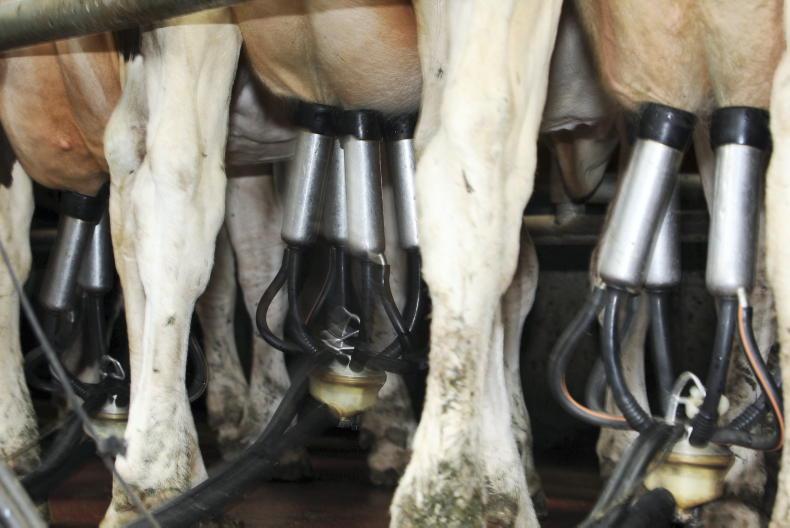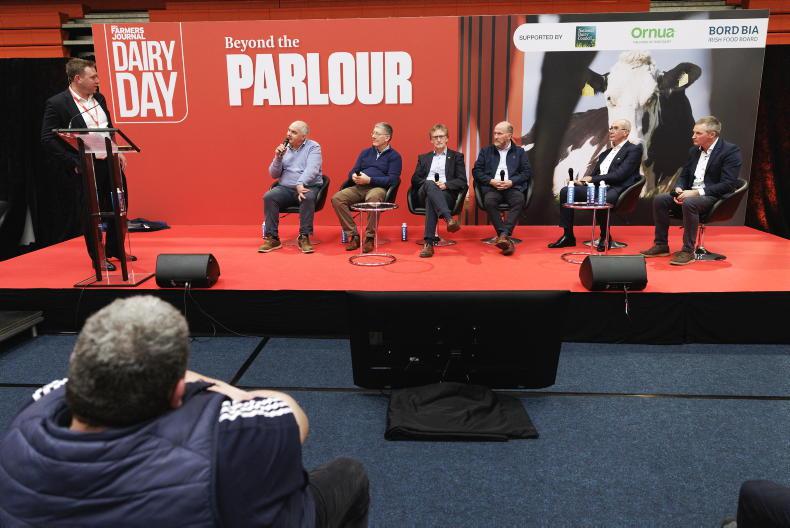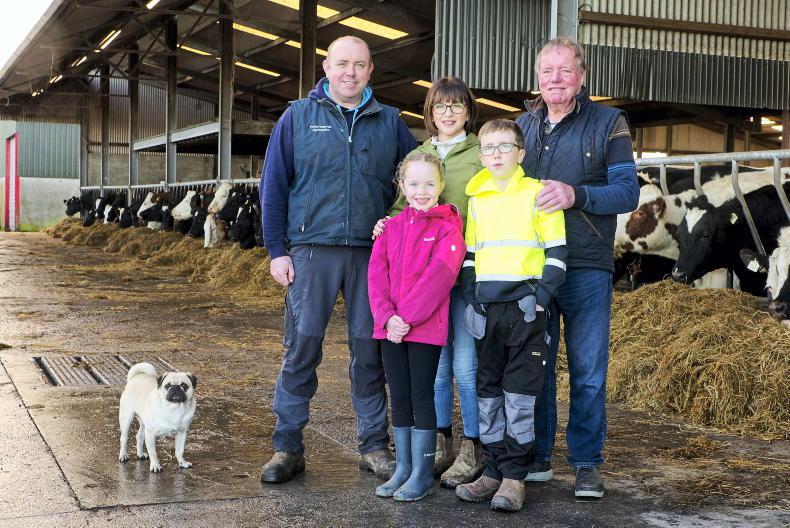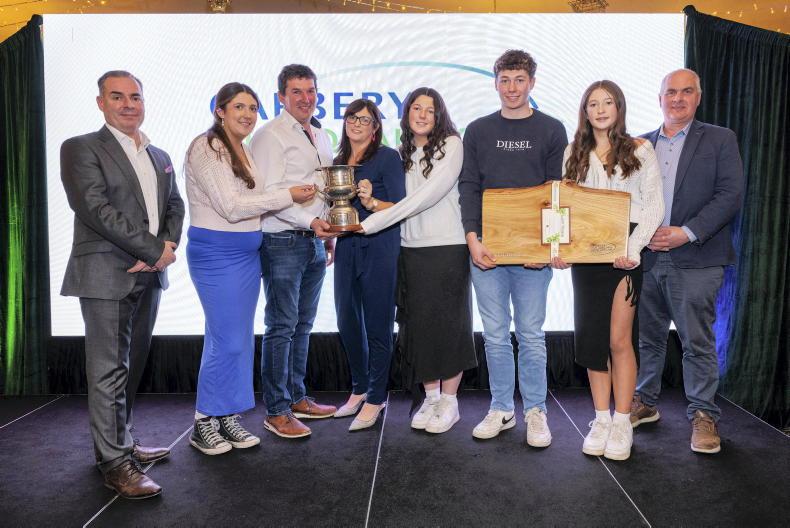Two years ago, Ireland was the first country in the world to implement an outright ban on chlorine-based wash routines in milking machines and in milk processing plants.
While the transition hasn’t been without its challenges, Teagasc researcher Bernadette O’Brien said it has been very successful from a chlorine residues perspective.
Trichloromethane (TCM) residue from chlorine is a known carcinogenic and can be an issue in butter as the residue binds to milk fat.
The target is 0.00124mg/kg while the average TCM residue for Irish milk is now almost half that at 0.0007mg/kg. Chlorate is another chlorine residue problem, which is linked to iodine deficiency in humans and especially babies, so chlorates in infant milk formula is a concern. Last year, chlorate could not be detected in 92% of all bulk tank milk samples across 3,500 farms.
With chlorine no longer available as a detergent steriliser, keeping milking machines and bulk tanks free of bacterial growth is a bigger challenge for farmers and milk quality advisers. This is because chlorine is an extremely effective cleaning product, so replacing it is difficult.
According to Teagasc researcher David Gleeson, the effectiveness of chlorine meant that it masked a lot of underlying cleaning problems and with chlorine no longer being used, some of these problems are coming to light.
The main bacterial challenges are thermoduric bacteria (THD) and total bacterial counts (TBC). Of these, thermoduric bacteria is more problematic because they can survive the pasteurisation process.
David says that cleaning routines have to change in order to compensate for the loss of chlorine.
“It’s not just a case of changing drums and carry on as normal, many farmers went from using chlorine-based detergents to chlorine-free detergents without altering the settings on automatic machines or how much they put into the wash trough.
“The amount of caustic in these products is much higher than chlorine-based products so they are much slower to suck up, meaning in most cases the machine is not getting enough product. It’s simple things that are causing most problems,” he says.
Products
There are two products needed to keep milking machines and bulk tanks clean. Detergents, such as sodium hydroxide (caustic), are available in liquid or powder form and are used to remove milk residues from the milk line. Acid is used to clean mineral deposits in the milk line. These mineral deposits are formed by water, so farmers in hard-water areas need to do more acid washes. Many farmers are now installing water softeners to reduce the hardness of water before it is used for washing.
Having sufficient amounts of hot water for the wash cycle is a crucial part of keeping the plant clean.
David says that it doesn’t matter what method is used to heat water, or how hot the water is after it comes out of the boiler; the key metric is how hot the water is at the start and at the end of the wash cycle.
“Measuring the temperature of the water coming out of the tap means nothing because it often takes so long for the wash trough to fill that the water has cooled before the wash starts.
“Another common problem is that the wash goes on for too long. This means that the water gets too cold and the particles that have been removed get reabsorbed on to the pipework. The target is for the wash cycle to last eight to 10 minutes. Anything longer than that is too long.”
Pre-wash rinse
He also said that many farmers are now using a pre-wash rinse with hot water to warm the pipes prior to the main wash cycle. This means that the wash cycle doesn’t lose as much heat during the wash.
He said they are doing this either by using the plate cooler water to rinse the plant after milking, dumping the first 10l to 20l of the hot wash cycle before adding detergent, doing a warm post-milking rinse with water at 200C to 300C or programming this warm rinse into the wash programme for automatic washers.
Using fast fill ballcocks and using lids and insulating wash troughs will help to maintain temperature of the water for longer. He said the target temperature for the start of the wash is 750C to 800C and 450C to 550C for the end of the wash.
David Gleeson said that he’s currently doing a study of milk quality on 100 dairy farms, 50 with good milk TBC and 50 with poor TBC, to see if there are trends between the good and the bad.
He has 60 farms surveyed to date and he said that every farm is doing some incorrect practices, even those with the good milk quality results.
Examples of some of the issues encountered are:
Products out of date such as acid drum expired.Detergent usage is half the rate required.No detergent used after the evening milking.Liquid detergent re-used.Detergent products sitting in the sun.Drum without label and no idea what the product is.Has run out of detergent for days.Long hot detergent wash cycles of 15 to 20 minutes.Same product levels used for both hot and cold circulation. No acid used.Wrong tubes in detergent/acid drums.Peracetic acid drum open and in use for 10 months. Double the amount of peracetic acid that should be used.Detergent steriliser (chlorine) products in use.No hot water used.Water supply issue, meaning cleaning takes a lot longer than it should.Wash trough is only half the size required.Low water levels for main wash cycle (5l per unit when it should 9l).Wash water start temperature less than 500C for liquid products.Hard water issue with a stain on trough surfaces.Poor drainage after wash cycles impacted on hot wash temperature and residues.Filter sock left in without rinsing for the full wash cycle and then replaced.No filter sock present for the wash cycle could clog the plate cooler.Clusters mounted for washing in wrong position.
The wash programme needs to include detergent to clean milk residues and acid to clean mineral deposits from water.
Kevin O’Neill, head of milk recording at Progressive Genetics, and Francis Quigley, milking machine specialist with Teagasc, spoke about the importance of correctly positioning milk meters on rotary milking parlours.
There are numerous health and safety risks when working around rotaries and more thought needs to be put into where the DIY milk meters will go for operator safety and to avoid damaging the meters.
Kevin said that only ICAR-approved milk recording devices can be used when milk recording but that many farmers install milk yield sensors thinking that they will comply but they don’t.
Chlorine residues are no longer a concern in Irish dairy products since the entire industry moved away from chlorine-based wash routines. Chlorine-based detergent steriliser masked a lot of problems with cleaning technique but with chlorine no longer available some of these issues are re-emerging. New wash routines using more hot washes and extra products are required to keep milking parlours and bulk tanks clean when using chlorine-free products.
Two years ago, Ireland was the first country in the world to implement an outright ban on chlorine-based wash routines in milking machines and in milk processing plants.
While the transition hasn’t been without its challenges, Teagasc researcher Bernadette O’Brien said it has been very successful from a chlorine residues perspective.
Trichloromethane (TCM) residue from chlorine is a known carcinogenic and can be an issue in butter as the residue binds to milk fat.
The target is 0.00124mg/kg while the average TCM residue for Irish milk is now almost half that at 0.0007mg/kg. Chlorate is another chlorine residue problem, which is linked to iodine deficiency in humans and especially babies, so chlorates in infant milk formula is a concern. Last year, chlorate could not be detected in 92% of all bulk tank milk samples across 3,500 farms.
With chlorine no longer available as a detergent steriliser, keeping milking machines and bulk tanks free of bacterial growth is a bigger challenge for farmers and milk quality advisers. This is because chlorine is an extremely effective cleaning product, so replacing it is difficult.
According to Teagasc researcher David Gleeson, the effectiveness of chlorine meant that it masked a lot of underlying cleaning problems and with chlorine no longer being used, some of these problems are coming to light.
The main bacterial challenges are thermoduric bacteria (THD) and total bacterial counts (TBC). Of these, thermoduric bacteria is more problematic because they can survive the pasteurisation process.
David says that cleaning routines have to change in order to compensate for the loss of chlorine.
“It’s not just a case of changing drums and carry on as normal, many farmers went from using chlorine-based detergents to chlorine-free detergents without altering the settings on automatic machines or how much they put into the wash trough.
“The amount of caustic in these products is much higher than chlorine-based products so they are much slower to suck up, meaning in most cases the machine is not getting enough product. It’s simple things that are causing most problems,” he says.
Products
There are two products needed to keep milking machines and bulk tanks clean. Detergents, such as sodium hydroxide (caustic), are available in liquid or powder form and are used to remove milk residues from the milk line. Acid is used to clean mineral deposits in the milk line. These mineral deposits are formed by water, so farmers in hard-water areas need to do more acid washes. Many farmers are now installing water softeners to reduce the hardness of water before it is used for washing.
Having sufficient amounts of hot water for the wash cycle is a crucial part of keeping the plant clean.
David says that it doesn’t matter what method is used to heat water, or how hot the water is after it comes out of the boiler; the key metric is how hot the water is at the start and at the end of the wash cycle.
“Measuring the temperature of the water coming out of the tap means nothing because it often takes so long for the wash trough to fill that the water has cooled before the wash starts.
“Another common problem is that the wash goes on for too long. This means that the water gets too cold and the particles that have been removed get reabsorbed on to the pipework. The target is for the wash cycle to last eight to 10 minutes. Anything longer than that is too long.”
Pre-wash rinse
He also said that many farmers are now using a pre-wash rinse with hot water to warm the pipes prior to the main wash cycle. This means that the wash cycle doesn’t lose as much heat during the wash.
He said they are doing this either by using the plate cooler water to rinse the plant after milking, dumping the first 10l to 20l of the hot wash cycle before adding detergent, doing a warm post-milking rinse with water at 200C to 300C or programming this warm rinse into the wash programme for automatic washers.
Using fast fill ballcocks and using lids and insulating wash troughs will help to maintain temperature of the water for longer. He said the target temperature for the start of the wash is 750C to 800C and 450C to 550C for the end of the wash.
David Gleeson said that he’s currently doing a study of milk quality on 100 dairy farms, 50 with good milk TBC and 50 with poor TBC, to see if there are trends between the good and the bad.
He has 60 farms surveyed to date and he said that every farm is doing some incorrect practices, even those with the good milk quality results.
Examples of some of the issues encountered are:
Products out of date such as acid drum expired.Detergent usage is half the rate required.No detergent used after the evening milking.Liquid detergent re-used.Detergent products sitting in the sun.Drum without label and no idea what the product is.Has run out of detergent for days.Long hot detergent wash cycles of 15 to 20 minutes.Same product levels used for both hot and cold circulation. No acid used.Wrong tubes in detergent/acid drums.Peracetic acid drum open and in use for 10 months. Double the amount of peracetic acid that should be used.Detergent steriliser (chlorine) products in use.No hot water used.Water supply issue, meaning cleaning takes a lot longer than it should.Wash trough is only half the size required.Low water levels for main wash cycle (5l per unit when it should 9l).Wash water start temperature less than 500C for liquid products.Hard water issue with a stain on trough surfaces.Poor drainage after wash cycles impacted on hot wash temperature and residues.Filter sock left in without rinsing for the full wash cycle and then replaced.No filter sock present for the wash cycle could clog the plate cooler.Clusters mounted for washing in wrong position.
The wash programme needs to include detergent to clean milk residues and acid to clean mineral deposits from water.
Kevin O’Neill, head of milk recording at Progressive Genetics, and Francis Quigley, milking machine specialist with Teagasc, spoke about the importance of correctly positioning milk meters on rotary milking parlours.
There are numerous health and safety risks when working around rotaries and more thought needs to be put into where the DIY milk meters will go for operator safety and to avoid damaging the meters.
Kevin said that only ICAR-approved milk recording devices can be used when milk recording but that many farmers install milk yield sensors thinking that they will comply but they don’t.
Chlorine residues are no longer a concern in Irish dairy products since the entire industry moved away from chlorine-based wash routines. Chlorine-based detergent steriliser masked a lot of problems with cleaning technique but with chlorine no longer available some of these issues are re-emerging. New wash routines using more hot washes and extra products are required to keep milking parlours and bulk tanks clean when using chlorine-free products.










SHARING OPTIONS